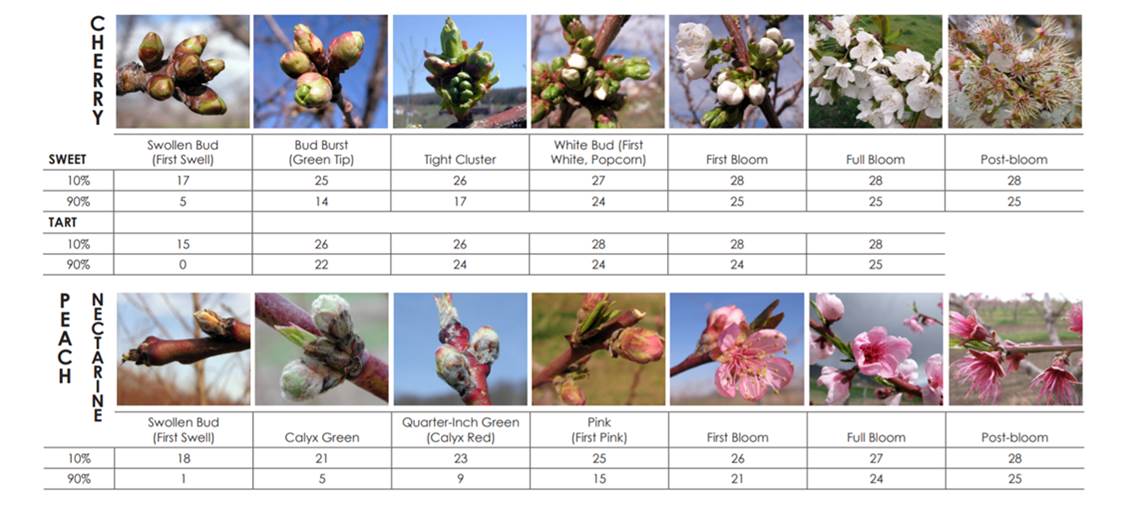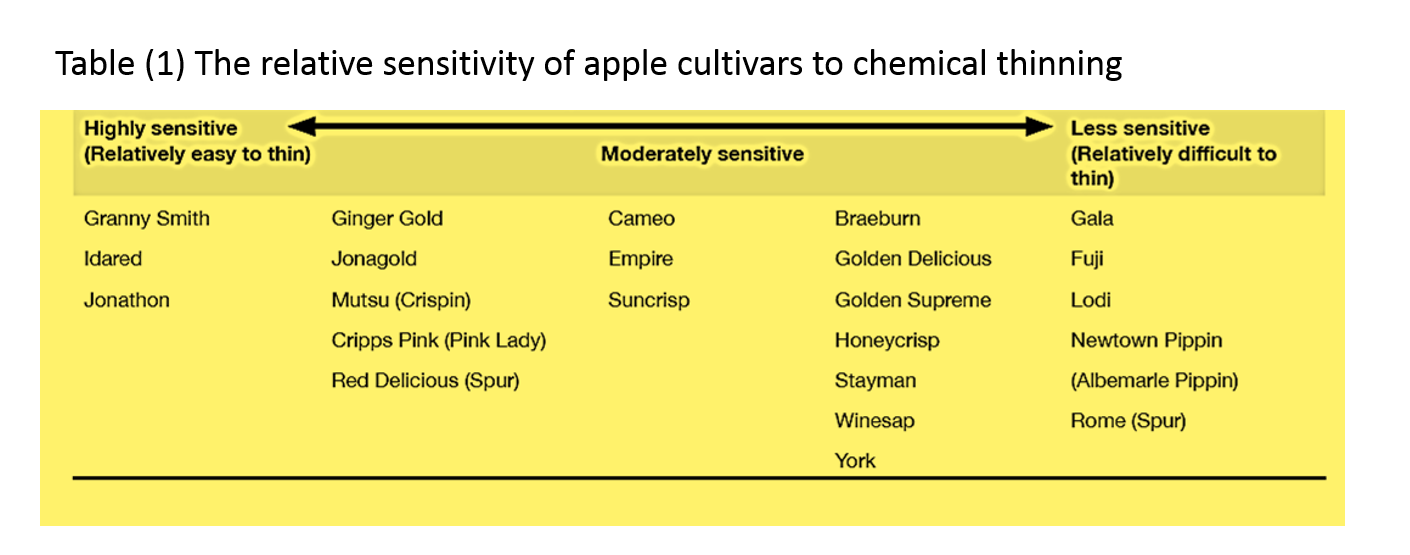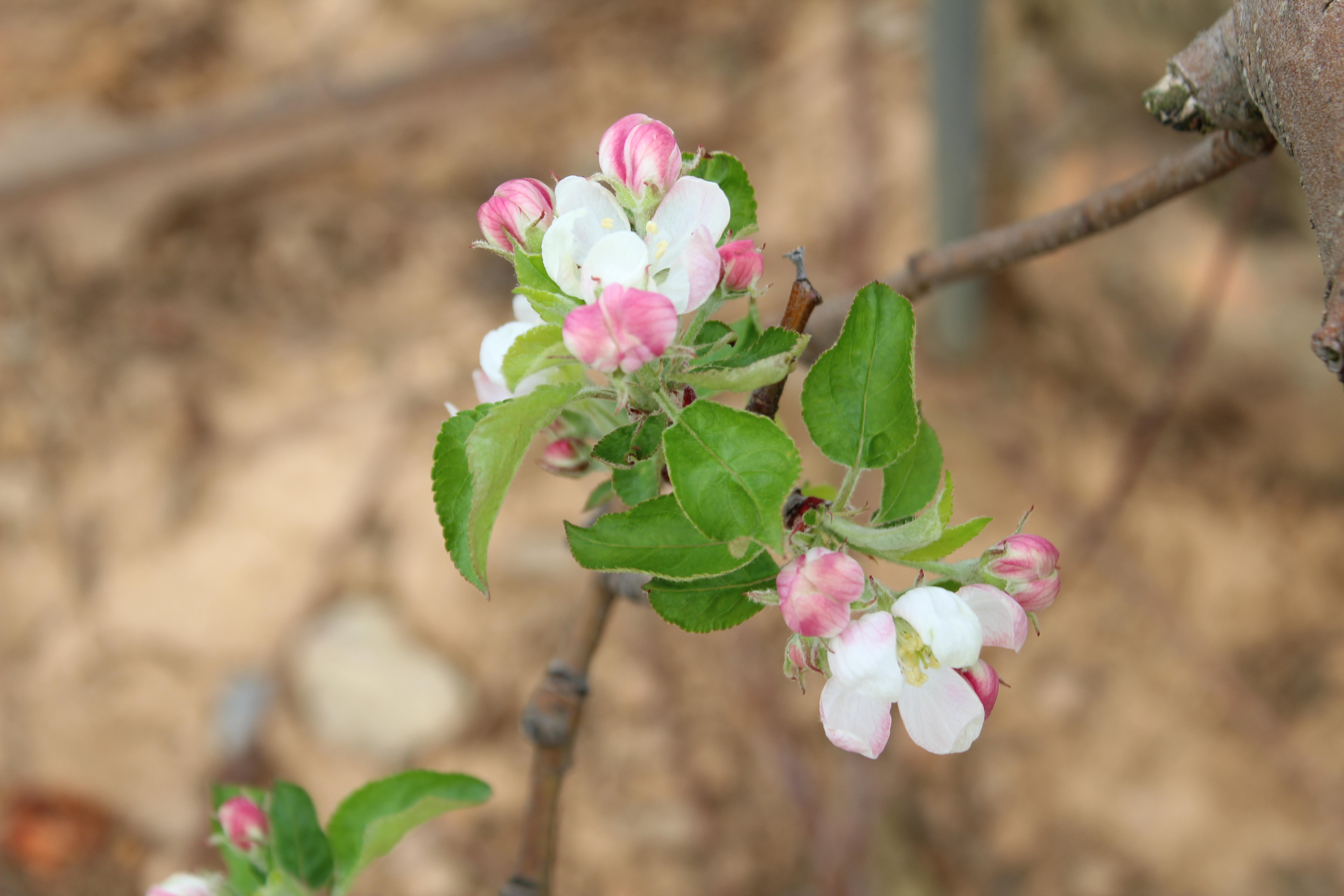According to the carbohydrate thinning model outputs for Winchester, we had only 1 day of carbohydrate surplus since the beginning of the growing season, with a value below 10 g carbon/day. This is mainly due to the several hot/cloudy/ and or rainy days and warm nights we had in the last two weeks. For those who started thinning applications last week (May 10-12), it might be wise to wait to see the effect of these treatments before starting extra thinning applications next week. For those who did not start thinning yet, Sunday (May 20) will probably be a good chance to apply your first thinning application. Fruit size will be < 15 mm for most apple cultivars and temperature will be good for 6-BA and NAA applications. As for today, we have Pink Lady at 16.5 mm, Fuji (12.35), Gala (15.6) and Honeycrisp (13.3). The model recommends applying the standard rate of chemical thinners and so do I.

For Central Virginia, the model outputs are almost similar to those of Winchester, with a more carbohydrate deficit is expected in the next three days. The model recommends reducing the rat of chemical thinners by 15-30%. Fruit size is > 15 mm now and 6-BA or NAA won’t be effective as thinners. Ethephon should be used instead if more thinning is needed. use ethephon (0.5 to 1.5 pints) + carbaryl (1 pint/ 100 gallon). For alkaline water, buffering the spray solution to a pH of 3 to 5 will increase chemical stability and effectiveness. With a temperature ≥ 85 oF, ethephon might result in overthinking.

Author Archives: S. Sherif
Perfect conditions for apple thinning sprays
I ran the carbohydrate-thinning model today for Winchester and Central Virginia, and it seems like we are in the right time for fruit thinning, in terms of fruit size, weather conditions, and the tree carbohydrate status. The average fruit size is between 8 – 15 mm, and the temperature will be 88 oF and 92 oF tomorrow (May 12) in Winchester and Central Virginia, respectively. The carbohydrate model predicts carbohydrate deficit until May 17 in both areas. The model recommends reducing the rate of chemical thinners by 15 – 30%. I would not encourage you to follow this rule, especially with the hard-to-thin apple varieties, like Fuji, Gala, Rome, York and Honeycrisp (see the table below). I would even use the higher dose of chemical thinners at this stage, and make it one strong thinning application, instead of two mild applications. Trees will respond well to 6-BA and NAA at this stage, and the likelihood of overthinning is low. It is not recommended to use NAA with Fuji and Red Delicious; as this may result in pigmy, seedless fruits. Instead, you can try a higher concentration of 6-BA (at 200 ppm), with carbaryl (1 pint) and a non-ionic surfactant (e.g. Regulaid). 6-BA is more effective when temperatures are above 85 oF and it increases the rate of cell division and final fruit size. NAA should give better results with Honeycrisp and York. You can use up to 10 ppm of NAA and mix it with carbaryl (1 pint/ a 100 gal) and a surfactant. If you do not know what chemical to use with your cultivar, use 6-BA. For de-fruiting young apple trees, use the maximum rates of chemical thinners (i.e. NAA at 10 ppm, carbaryl at 2 pint/100 gallon, and a Regulaid at 1/2 pint/100 gal).
The apple carbohydrate thinning model for 5/8 to 5/11
Below is the carbohydrate thinning model outputs for Central Virginia. We used the weather station of Crown Orchard at Betesville, for temp. and solar radiation values. The model predicts carbohydrate deficit until May 14th, which is good for chemical thinning.
You may consider using the maximum rates of 6-BA (200 ppm), and NAA (10 ppm) and adding a non-ionic surfactant to your tank (see the table below) to enhance thinning efficiency.
We will start the model for Winchester/Frederick County when we reach a fruit size of 8 mm in Gala. As of today, the fruit size of our apple cultivars in the AREC’s research farm ranges between 4-5.8 mm (see the table below).
Apple Carbohydrate Thinning Model for 5/ 4 to 5/ 7, 2018
Greeting!
Below are the outputs of the carbohydrate thinning model for Winchester area. I used Gala’s green tip and full-bloom dates to run the model, but this should be working for the majority of apple cultivars. The fruit size of most cultivars we have in our research farm ranges between 3-5 mm. We usually recommend a fruit size of 8-15 mm, to start post-bloom thinning applications. So, the purpose of today’s post is to remind you of the basics of this model and how to read and interpret the outputs. Basically, we use temperature and solar radiation data from the nearest weather station to our orchard in order to calculate how much carbohydrate a mature apple tree would make a day (g/ day) starting from the green tip date; and how much carbohydrate a tree would demand. If the balance between the carbohydrate supply to demand is negative, the sensitivity to chemical thinners will be high, but if this balance is positive, the response to chemical thinners will be low. Cloudy days, warm nights and high temperatures for a number of days negatively affect carbohydrate production and result in carbohydrate deficit; whereas sunny and cool days promote photosynthesis, leading to carbohydrate surplus. In the chart below, the blue line shows the daily carbon balance, whereas the red line shows the average of four days (the present day and three days in advance). We consider the four-day average (the red line) when deciding for thinning time and rate.
Beside the temperature and solar radiation, the percentage of the source to sink organs also determines the tree carbohydrate balance, and subsequently the response to chemical thinners. Therefore, in the chart above, you will notice a carbohydrate deficit in the last five days despite the sunny weather. This is mainly due to two reasons: a) temperatures were high (> 88 oF) which encourages photorespiration, not photosynthesis; b) the demand of sink organs (i.e. flowers, young fruit, young leaves, buds) to carbohydrate is higher than what source organs (i.e. mature leaves) can provide at this stage (see the figure below). This balance between sink to source organs will change as leaves mature, and the competition among sink organs decreases.
Note from the model developer (March 22, 2018):
“The apple carbohydrate model simulates the response to weather of trees that are healthy with normal vigor and bloom, no significant water, nutrient or winter or spring freeze stress, and no significant carry-over stress from a previous year that will change tree responses. We are less confident in the model if temperatures are extremely cold or hot. Each orchard is unique, so use this tool, as any other, in the context of your own experience”
Defruiting young apple trees
Regarding the freeze warning tonight (4/18/2018)
As you may be aware, temperature are going to drop to a freezing point (32 oF) tonight and tomorrow night in most parts of Virginia (see the freeze warning: http://www.fox5dc.com/weather/freeze-warning_62343395). Most peach and cherry varieties are in full bloom now and this weather might cause a slight damage to the open blossoms, but we are not close to the critical temperatures that would cause serious damage to the crop. Here is the chart of critical temperatures for frost damage.

Source (https://digitalcommons.usu.edu/cgi/viewcontent.cgi?article=1643&context=extension_curall)
If you would consider turning-on your sprinklers to mitigate the effect of these freezing temperatures, here is the link to my previous post on using sprinklers for frost mitigation (https://blogs.ext.vt.edu/tree-fruit-horticulture/2017/03/12/sprinklers-for-frost-protection-are-they-worth-using/)
As for apple, this cold weather should not be a concern at this this point of bud development. Most apple varieties in our research farm in Winchester are still in the pink or loose cluster stage. Only Pink Lady and Arlet have some clusters with king bloom. Temperatures that would cause serious damage at this stage should be below 25 oF, which is luckily not the case for tonight or for the rest of this week.
Promoting return bloom in apple
The initiation of the next year flower buds occurs 2-6 weeks after bloom. Therefore, if the tree is exhausted in producing more fruits and/or vegetative tissues during this period, the initiation of flower buds will be negatively affected, and less return bloom will be obtained. Fruit thinning during this period, either chemically or by hand, helps the tree to direct some of their photoassimilates to the production of the next season’s flower buds. It has also been proven that treatments with some PGRs, particularly NAA and ethephon, after the thinning period ends (~ 6 weeks after bloom), can also promote bud initiation and subsequently return bloom.
Based on the results of many field trials, four bi-weekly sprays of NAA (5 ppm) and ethephon (150 ppm) beginning six weeks after full bloom promote return bloom in apple. These sprays can be added to the cover spray. However, if the tank is mixed with oil or a surfactant, the rates of NAA and ethephon should be reduced by 1/3. These rates should also be adjusted to the tree raw volume. Increasing water amount by 3-4X will enhance the positive effect of these treatments.
Updates on the carbohydrate thinning model- (May 16-21)
-
The following is a note of caution from Alan Lakso, the developer of the apple carbohydrate-thinning model (May 11, 2017):
“• The apple carbohydrate model assumes that the trees are healthy, normal vigor, have no significant stress (frost, drought, nutrient) and no significant carry-over effects from previous years that might change the tree response to the weather. With the severe drought in 2016, there may be orchards that will have a weakened state coming into 2017 which would likely make the tree abnormally sensitive to thinners. So in those cases the model may suggest a stronger thinner concentration than is appropriate. Conversely, if irrigated last year, with the warm season and lots of sun, those trees may be in better than normal condition and harder to thin.
• With the current cold period, flowering, pollination, initial set and early fruit growth may not be very well modeled as we did not have much data under these very cold (or also excessively hot) conditions when the model was developed.
For all these reasons, you should have less confidence in the model this year. Use your experience with your unique situation.”
-
Here is my take on this:
– I have not observed any unusual or extreme conditions in Virginia in the last few weeks that would seriously affect the accuracy of the model in predicting the timing and rate of chemical thinners.
– We have applied chemical thinners (e.g. 6-BA, NAA) to our Fuji and Gala trees in Winchester lab based on the model recommendations and we got fruit thinning enough to call it good.
– The fruit size in Winchester and Central Virginia is above 20 mm and rescue thinning using ethephon would be the only chemical thinning option at this time. For ethephon, the variety sensitivity and temperatures are more important factors to consider than the carbohydrate level.
-
Therefore, I would recommend the following for this week’s thinning treatments:
– The weather forecast predicts temperatures close to 90 oF this week, which will increase the responsiveness to ethephon applications and might lead to over-thinning if the proper rates are not used.
– The carbohydrate model for Winchester and Central Virginia predicts carbohydrate deficit for the following six days (until May 22), which should also increase the responsiveness to ethephon. The model has already stopped providing any recommendations for the rates. However, if you will apply ethephon this week, I would recommend decreasing the rate by 30% at least and not to add oil or a surfactant to the ethephon-carbaryl mix.
– Rome Beauty and Golden Delicious are highly sensitive to ethephon and under the above-mentioned conditions; it might be risky to use ethephon with these varieties.
The following is the carbohydrate model for Winchester and Central Virginia.


Apple Carbohydrate Thinning Model-Updates-(May 08 – 12)
At such advanced stage of apple fruit development, 6-BA and NAA are no longer effective as chemical thinners and it is the time to start the “rescue thinning” applications. The fruit size for most varieties in Winchester is close to 20 mm and it would likely be above 23 mm in Central Virginia. Ethephon is the most effective thinner at this stage. Ethephon thins more effectively when the temperature is in the 70s to low 80s. Although the weather forecast predicts cool temperatures this week, increasing the rate of chemical thinners by 30% might mitigate this negative impact of low temperatures. Mixing carbaryl (1 pint/100 gal) and oil (1-2 qt/100 gal) with ethephon (0.5-1.5 pints/100 gal) enhances its effectiveness and it might show desirable effects under the weather conditions of this week. The addition of NAA (5 ppm) to ethephon/carbaryl mix might be an option if more aggressive thinning is still needed. However, this application should be avoided with Delicious and Fuji as it will lead to the development of pigmies. Adjusting the pH to 3-5 is recommended with ethephon applications. Non-ionic surfactants (e.g. Regulaid) can also increase the response to ethephon applications.
As shown in the graphs below, the apple carbohydrate-thinning model predicts carbohydrate surplus for the whole week and likely during the weekend in Winchester and Central Virginia. Under such conditions, the recommendations are to increase the rate of chemical thinners by 30%.

Apple Carbohydrate Thinning Model-Updates-(May 02 – 05)
Unlike last week, weather forecast predicts conditions that will likely lead to carbohydrate surplus and subsequently, less thinning efficiency this week (May 01-05). As shown in the images below, the carbohydrate model predicts accumulation of up to 35g/day carbohydrate this Friday. This, in turn, will necessitate a 30% increase in the rate of chemical thinners that will be applied tomorrow, Thursday or Friday. I believe we are still within the good thinning window in terms of fruit size, but this week might be the last chance for (6-BA + Carbaryl), or (NAA + Carbaryl) sprays to show an effect.
The following is the carbohydrate model for Winchester and Central Virginia.












